In your eyes – Interview with Stuart Hahn – Omo Valley 2020 & 2023
27th April 2023
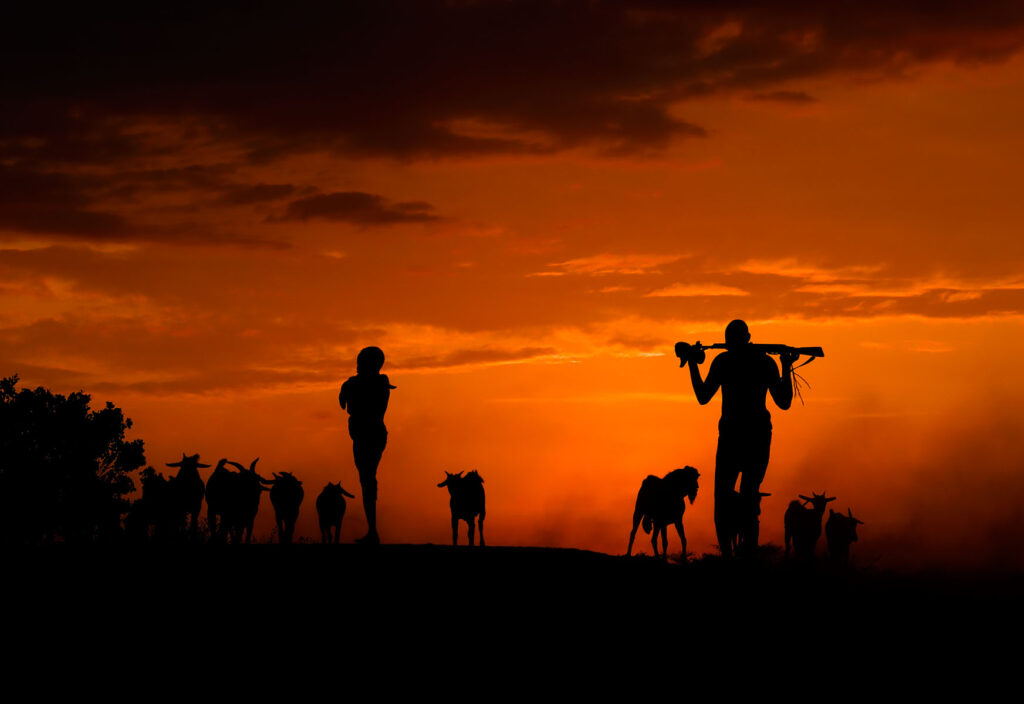
Karo family herding livestock at sunrise (image by Stuart Hahn). Why Wild Images loves this – we had been kindly invited by a local Karo family to join them at sunrise while they herded their livestock. Not only were we blessed with a stunning dawn, but it was nice to see the different roles each family member played from the elder boy carrying a gun to protect the flock, a little boy carring a sheep that couldn’t walk on his own etc. This image in silhouette really captures the magic and movement of that morning, transporting the viewer to another world, a world of remote Africa and the way people live every day.
Tell us a little more about your photography journey. How long have you been taking photos?
First I would like to thank you for giving me the opportunity to comment on our 2022 trip to the Omo Valley tribal areas. To answer your specific question, I have always had some interest in photography; however, it was not until around 1998 that I became more seriously interested in his activity. It began when I read about a photo trip to the Southwest in the US. I thought it would be interesting to go to places I had never visited as well as learn more about photography. On the initial trip I was shooting film with manual focus camera. I realized there was a lot to learn. Since then my wife and I have travelled extensively around the world almost always doing photography along the way.
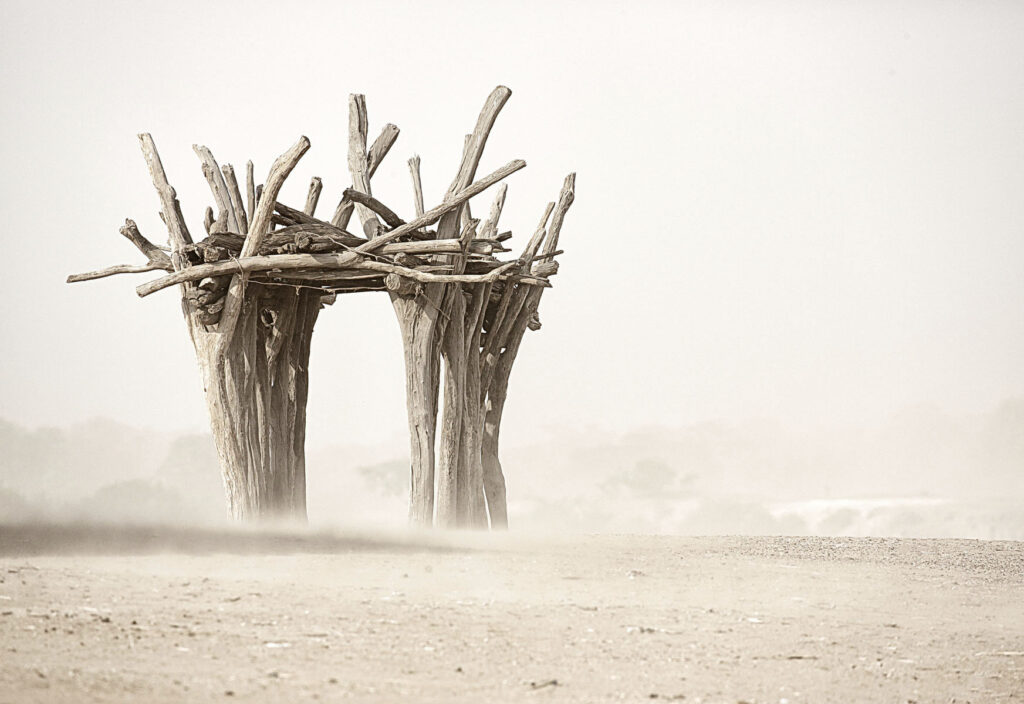
Ceremonial portal in the Karo village of Dus (image by Stuart Hahn). Why Wild Images loves this – This Karo village is very beautiful with fascinating African vernacular architecture. Many of the buildings are made by hand using heavy riverine hardwoods. We were visiting during a dust storm and the dust in this image removed most of the ‘busy’ details in the background, enhancing the shape and style of this beautiful structure.
What are you passionate about besides photography? What do you do in your free time?
My main interest outside of photography is gardening. We have a half acre lot so I have room to have a nice garden. I/we also have quite a few mini hobbies that include collecting realist urban landscape paintings, antiques, and, out of necessity, maintaining an older home.
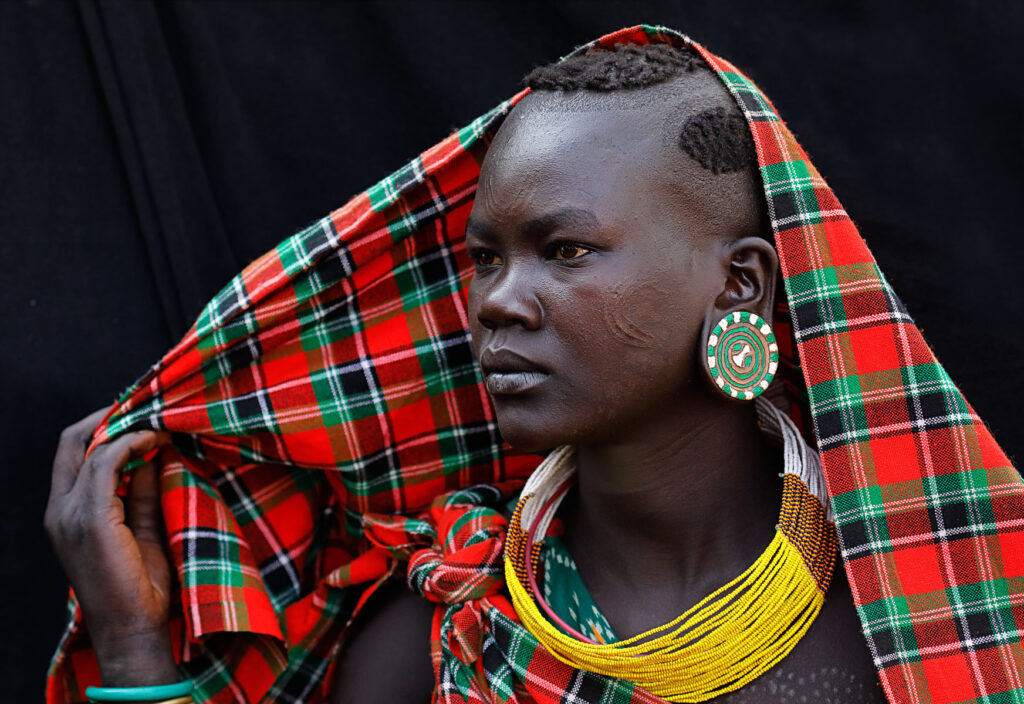
Portrait of a Suri woman with her disc earring and scarification (image by Stuart Hahn). Why Wild Images loves this – when we saw this image it reminded us of the classic ‘Girl with a Pearl Earring’ painting by Vermeer but with the twist of an African woman wearing an earring she has made by hand from clay and the tremendously beautiful scars on her face that link her to her culture.
How many years have you been visiting Africa?
Our first trip to Africa was in 2006. Since then we have returned for about 12 trips. Usually I travel with my wife. Other times, such as the Omo Valley trips, I travel alone, usually with a photo group. In 2022 besides the OMO trip I will be returning to Madagascar on a private photo trip.
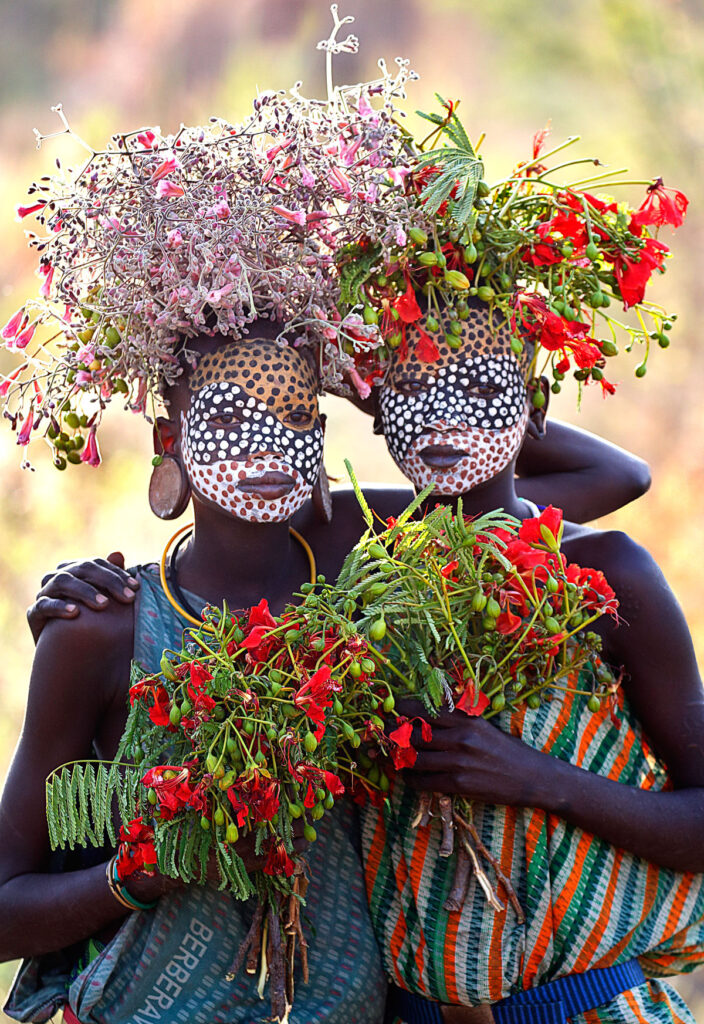
Portrait of two Suri flower girls (image by Stuart Hahn). Why Wild Images loves this – it’s hard to fault photography of Suri people. Not only are they natural artists, utilising the world around them to create, they have an affinity for colour, shape and form. We love this image because the depth of field is perfect and the backlighting of the early morning sun almost gives these girls an ethereal beauty.
What draws you to Africa constantly?
The trips I enjoy the most are those that expose me to multiple different photo opportunities during the individual trip. In Africa, on a typical wildlife safari, there is the large variety of animals seen and on trips such as to the OMO and to Namibia there is the opportunity for quite varied experiences. On the Omo trip specifically there are the many different tribes that one can visit and also the opportunity to witness some of their traditional ceremonies.
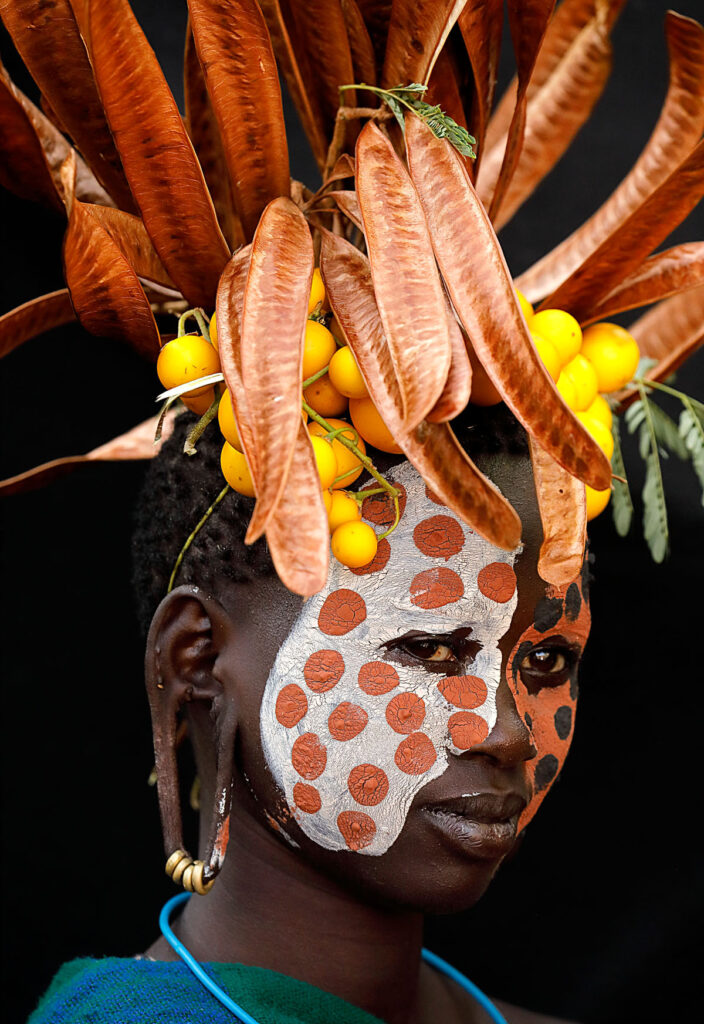
Portrait of a Suri girl with her head dress of Solanum berries and Cecropia seeds (image by Stuart Hahn). Why Wild Images loves this – This image breaks all of the rules of composition in portrait photography, yet it shows this lady’s beautiful face in focus below the amazing collection of seeds and fruits in her head dress which is slightly out of focus, enhancing her appearance.
You are principally a wildlife photographer. What inspired you to visit the Omo Valley to photograph people?
In the beginning, I primarily did landscape photography in the Southwestern US. Sometime later I became interested in bird photography. We have some great well known places in the US for photographing birds such as New Mexico and Florida. When I started out doing bird photography it was a challenge especially with the equipment we had then. It was the days of film, bracketing, and having to know your exposures. There were no LCD checks to make sure your exposure was correct.
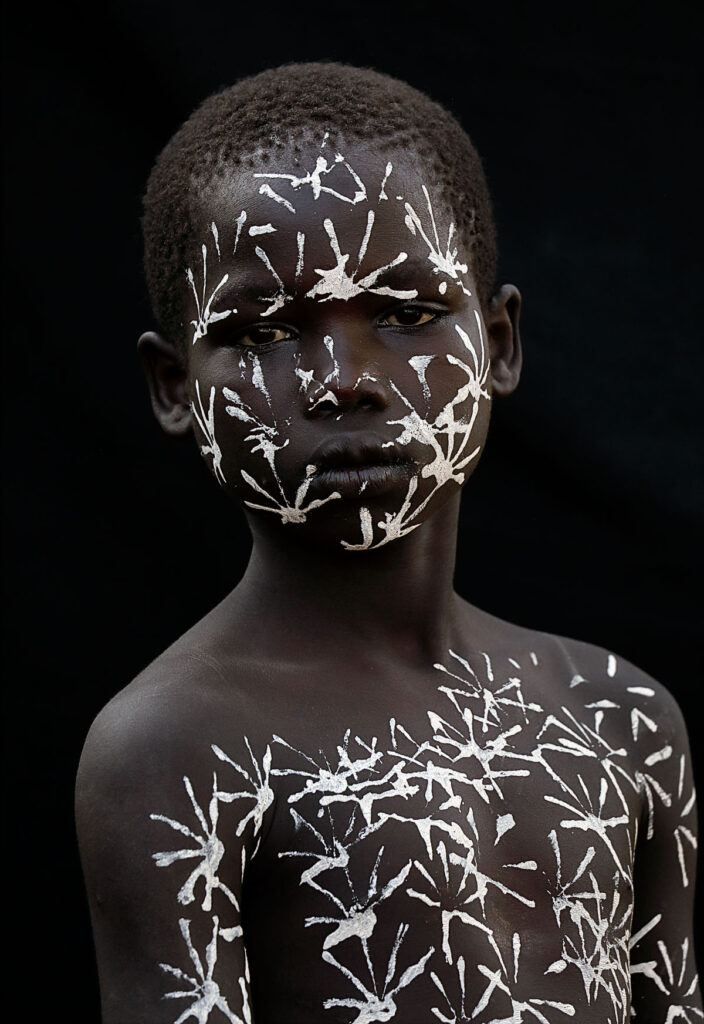
A painted world with stars (image by Stuart Hahn). Why Wild Images loves this – The Suri have two main ways of painting their bodies and so much of what they do is done for photographers that it is hard to know what is traditional and what isn’t when you visit. This young boy had painted himself with star shapes using the base of a reed. We loved this photo as initially it looks like stars and then you realise there is a person in it also. It looks like it was shot at night but in fact was taken early in the morning against a black backdrop.
What camera gear did you use on your tours?
In the beginning I used Nikon F3s that were manual focus cameras. When I began to do bird photography it coincided with the development of the auto focus bodies. Currently I am using Canon cameras. For the photos taken on the Omo trip I used both a 5D mark III and a 5D mark IV. The lenses used included a 24-105mm and a 100-400mm lens. A 70-200mm 2.8 lens would also be a great lens to take in that we were often shooting in low light situations.
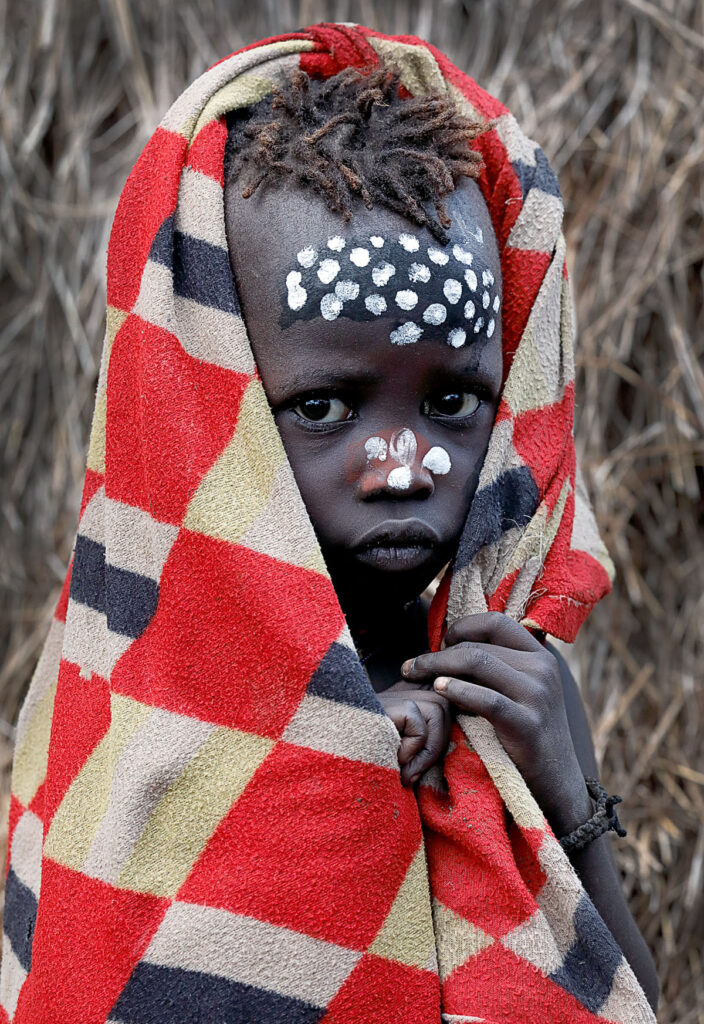
A shy Mursi child keeping warm (image by Stuart Hahn). Why Wild Images loves this – we visited the Mursi people of Ethiopia at sunrise after a drive through the wilds while it was still dark. When we arrived it was quite cool so this little Mursi girl had wrapped herself in her blanket to keep warm. She was outside her home, and the backdrop of her hut contrasted beautifully with the textures in her hair and her signature face paint of her culture.
What were your first impressions of the Omo Valley for photography?
It is a great place to learn a type of portrait photography. To see and photograph remote tribal people who are so open to share their world, even briefly, with us. I do not feel the photography is that difficult for anyone except possibly a novice photographer? It would be very difficult to not come away with some really great shots.
What surprised you about your first trip there?
I think it was how well our trip went logistically given the somewhat challenging nature of such a trip.
What were your frustrations on your first trip?
Well on both trips the one in 2020 and 2022 we had 6 days of camping. On the first trip the camping was a little more rustic and it was much better on the 2022 trip. We had a shower on the second trip and the toilet facilities were improved. All in all the camping went very well.
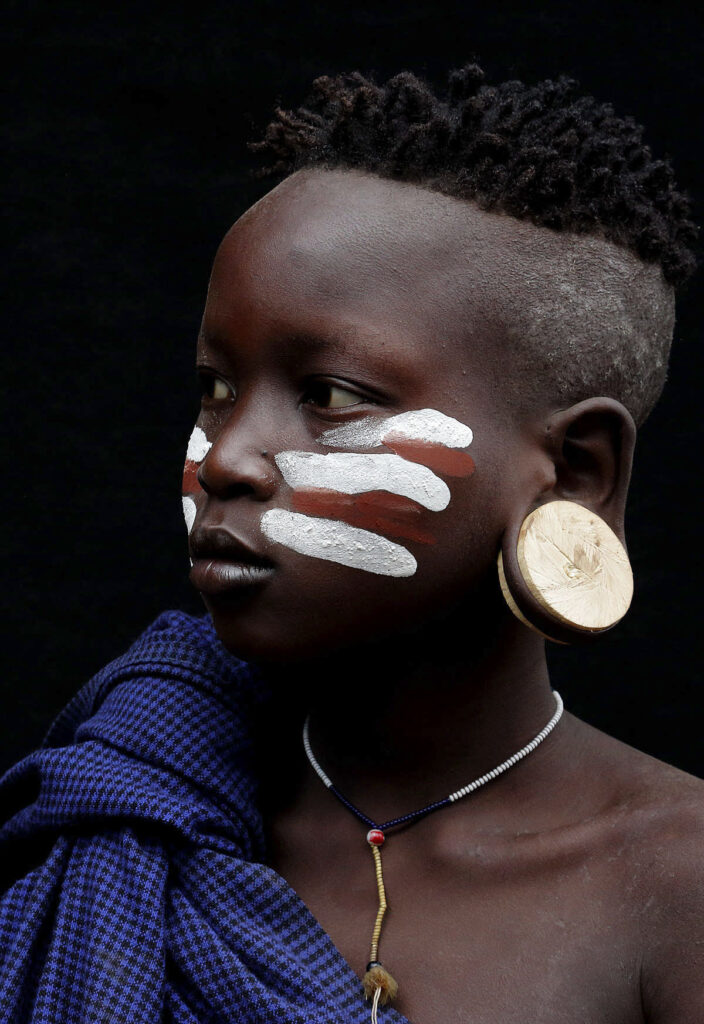
Portrait of a Mursi girl in profile (image by Stuart Hahn). Why Wild Images loves this – This young Mursi girl was in the process of becoming a woman and she was wearing the simple wooden plug that would stretch her ear to prepare for a more decorative ear plate made from clay that she will wear when she is older. The natural texture of the wood, the paint on her face and her beautiful serene expression created a magical image of the Mursi.
What made you return?
It is quite an adventure which made it a lot of fun besides the fact that the photography was just so good and interesting. Also it was a very well-organized trip as I mentioned above. Finally Inger’s disarming approach and genuine embracement of the people was critical to the success of the trip.
You have been twice to the Omo Valley now with Wild Images. What were your thoughts on your second trip?
It was similar to the first trip in a lot of ways. However, on this particular trip we were very fortunate to be able to witness some very special events that I had not seen on the first trip. One such activity was Donga or stick fighting; another was the opportunity see scarification being done on a young woman by two of her friends. So, it is a good example of the observation that it can be good to return to an interesting place as it will often offer different photo opportunities.
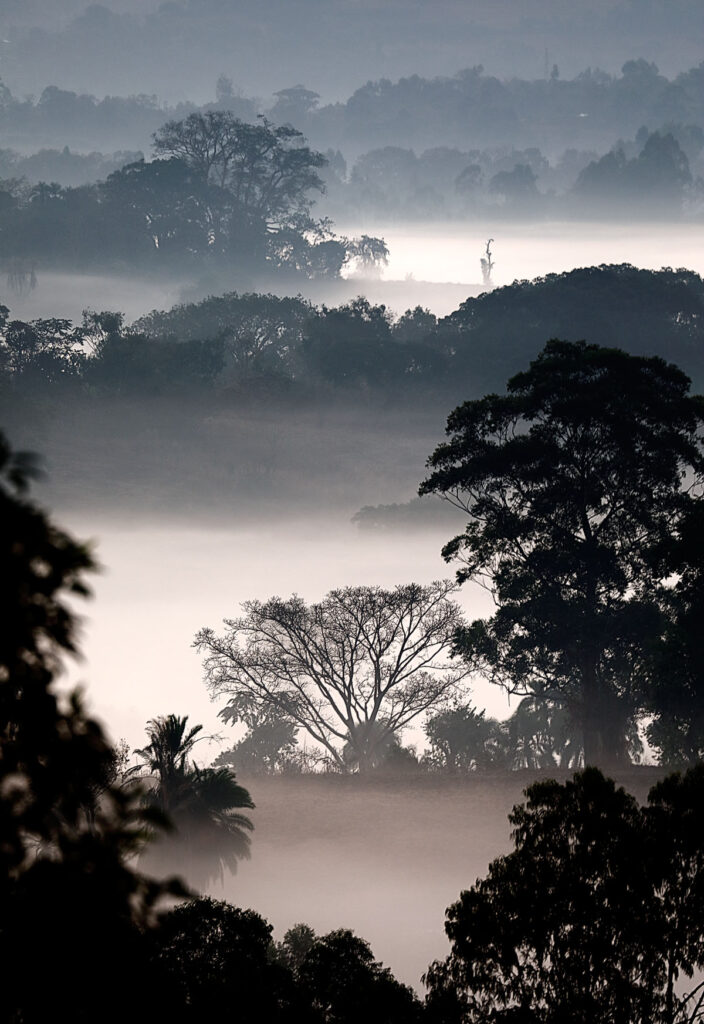
Layers of mist in the valleys of Maji (image by Stuart Hahn). Why Wild Images loves this – not a lot of tours stop in the Maji zone on the way to the Omo Valley. When we were travelling on the first day of the tour we noticed layers of mist that had formed in the agricultural region of Maji. We loved this image due to the different layers of light and silhouetted vegetation, which lent it an almost magical air.
Of all the people you have met on these tours, do you have a favourite group of people that you prefer to photograph?
I do not think of it so much in that way as all the tribes offer different opportunities for good photos. If I had to choose, I would not want to miss the visits with the Suri people since the way the dress up for photographers is so different and colourful. I would add that the Hamer people also are a favourite, again due to their unique manner of dressing and application of coloured clay to their bodies and hair.

Portrait of a young Arbore girl in the doorway of her home (image by Stuart Hahn). Why Wild Images loves this – this is another image that breaks the rule of thirds beautifully with this young girl looking pensively away from the photo. What is lovely about this image is her expression and the colours which tie her earthy complexion to her surroundings.
Aside from the photography, what other aspects of the tour did you enjoy?
As I mentioned above, the overall experience was a big draw for me. The fact that the group was small, 5 people plus the leader, was also an attraction. We had a good group of fellow photographers with interesting backgrounds. Our leader was fantastic and very skilful in getting us in position for some great photographs.
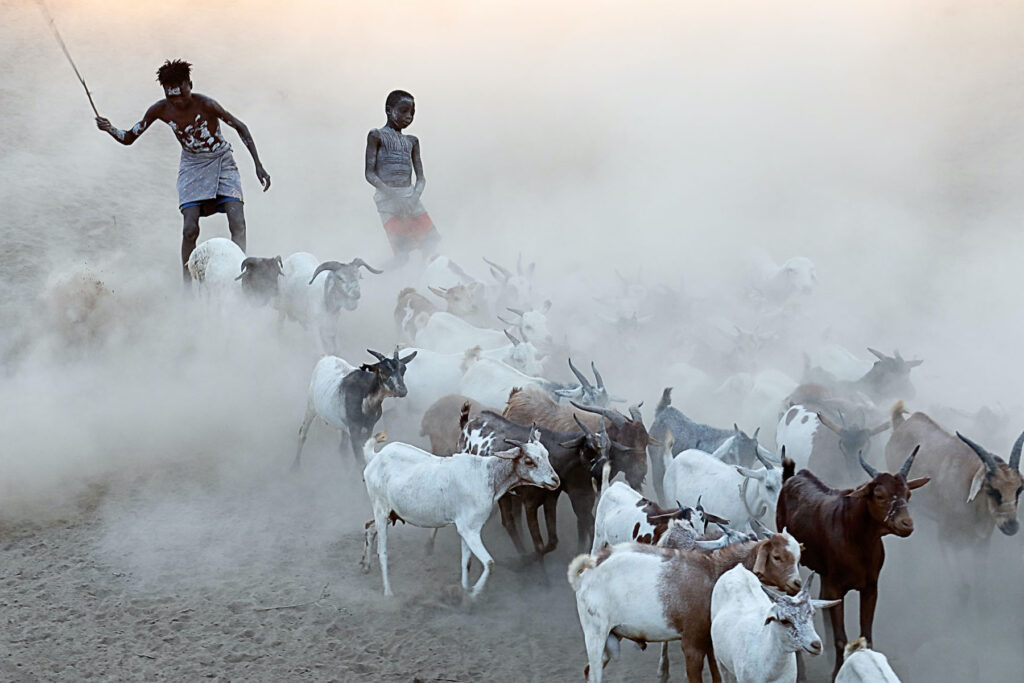
Herding goats and sheep in the dust of the Karo area (image by Stuart Hahn). Why Wild Images loves this – As the sun rose higher in the Karo area, the light enhanced the dry and dusty conditions we encountered with a local family herding their flock. The end result was images like this where both animals and people emerged from clouds of dust like ghosts. This photo really encapsulated the incredible atmosphere we experienced that morning.
What have you learned from your tours to the Omo Valley?
Well I learned a little about the lives of the people we visited. I also learned about some of the issues impacting their way of life. And, I always learn something new in photography.
Do you have any advice for photographers visiting the Omo Valley?
My best advice in all sincerity is to go with Wild Images and if possible on a trip led by Inger.
Also be flexible and open to new experiences
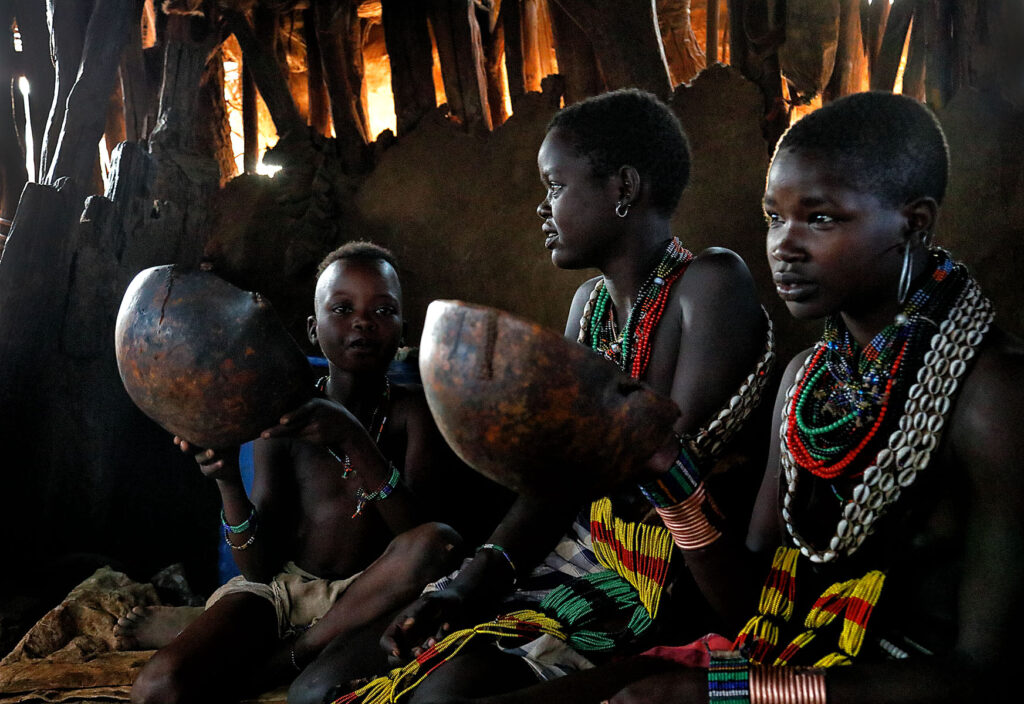
Hamer girls at home (image by Stuart Hahn). Why Wild Images loves this – this photo is actually a really difficult shot to capture. Not only is the scene very dark but you have a lot of backlighting coming through the walls behind. It makes for slow shutter speeds and a very challenging exposure yet Stuart managed to get around these limitations to capture life inside the home of a Hamer family, with all of the warmth, hospitality and charisma that these people have.
Are there any images that are particularly special to you?
When I came back and after some serious editing I had around 130 images that I felt were special. My biggest problem was that when I was asked to pick my favourite 20 images I was unable to get down past 40. I hope that in some way address the question. I think some of my images that are attached to this interview will demonstrate that we had many opportunities for good if not great images.
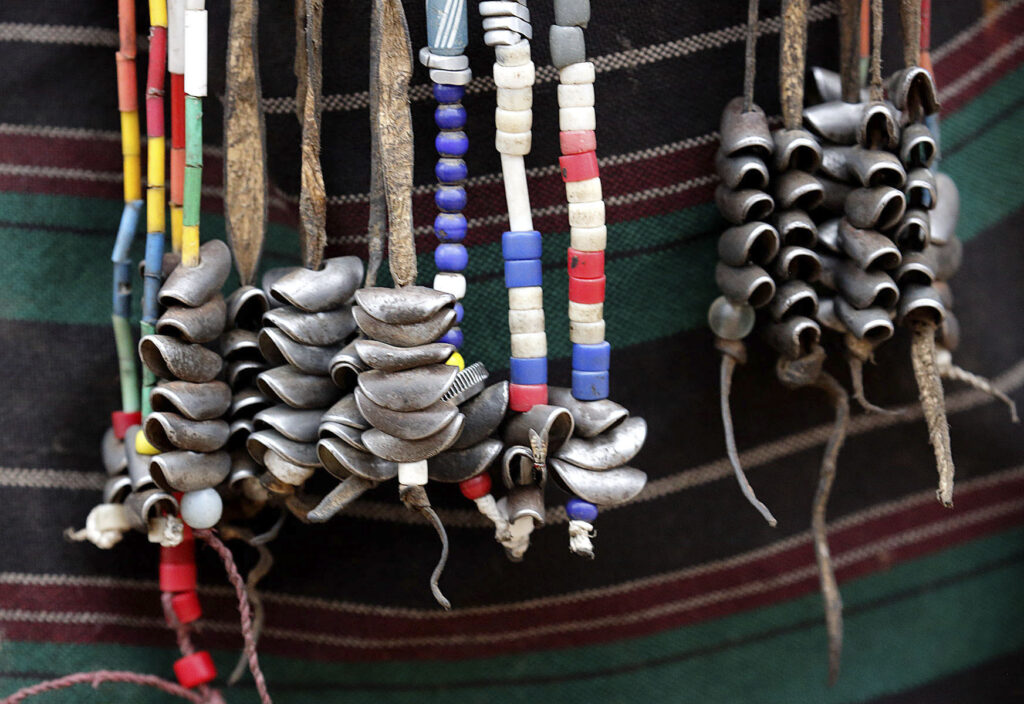
Decorative detail of a Hamer man (image by Stuart Hahn). Why Wild Images loves this – We always try to encourage our guests to really think about the person they are photographing on our tours and how they dress. This image is wonderful as it shows an evolution in the decoration of Hamer people, combining traditional metal beads with modern plastic ones, bottle tops and even bullet casings, to create an overall beauty and style unique to the person wearing it.
Would you return to the Omo Valley?
Another interesting question, this asked of someone who has already made two trips. I think the answer has to be yes since it was such a fun trip and the photography was so spectacular. I have also met some great people on these trips.
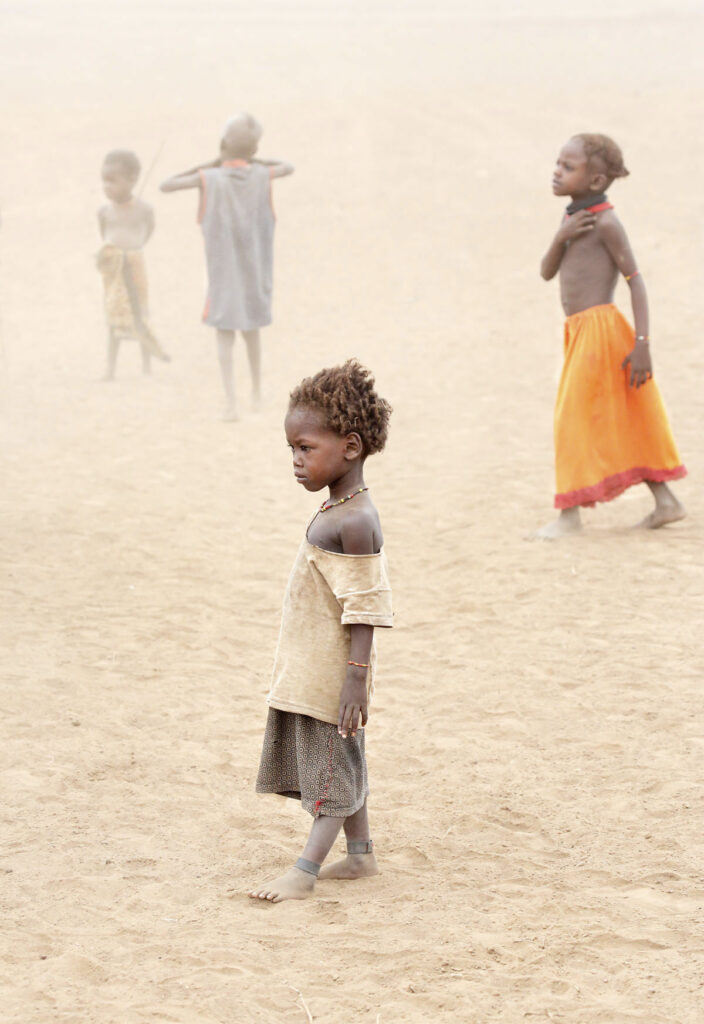
Dassanech children in a dust storm (image by Stuart Hahn). Why Wild Images loves this – it’s always difficult to know how a guest will interpret such a spontaneous scene like a dust storm. We had so little time and the storm in this photo disappeared almost as fast as it rose up. We loved this photo as it had different layers of children weathering this event in a very stoic way, with some of them fading into the storm in the background.

